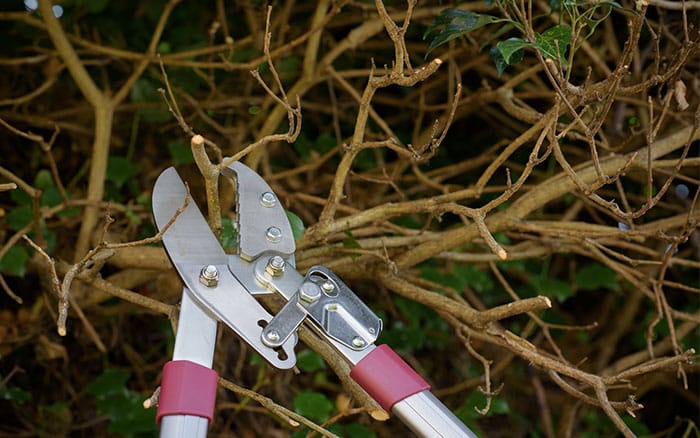Falling temperatures may have sealed the fate of many of your gardening jobs but pruning isn’t one of them. Plants and trees that lose their leaves are dormant in winter and this makes it the perfect time to snip, clip and slice them back into full health for the upcoming spring.
So get those secateurs at the ready, it’s time to trim…
Chop sticks

With the leaves shed, plant resources are focused in the roots and this makes it easier to judge the plant’s shape and condition. No more cutting it fine, we’re cutting it right!
Plants that benefit most from winter pruning include vigorous climbers that flower on the current year’s growth, newly planted deciduous hedges and deciduous trees.
You can even prune fruit trees like apple and pear trees that you wish to better establish as a winter prune with keep the growing larger in size. Whereas those you don’t want to get much bigger will need regulated pruning.
Leave plants that bloom on last season’s growth, like Forsythia and Philadelphus (mock orange), otherwise you’ll be cutting off the wood that would’ve produced flowers come spring!
Most evergreens are also best left as pruning now can encourage new growth which could be killed off by frost. Use the RHS plant finder to determine which category your plants fall into before you start.
[adinserter block=”10″]
Drop dead weight
There is one exception to this; all plants need the three D’s – Dead, Damaged and Diseased branches – removed as soon as you spot them. So, chop chop! Pruning away this material prevents disease spreading and creates space for healthy new growth to come through.
One of the greatest benefits of ridding this growth though, is that is refocuses the plant’s energy onto healthy growth, worthy of precious resources in the depths of winter. It is particularly important to remove dead or weakened branches on trees at this time of year – otherwise they could be brought down by storms and cause damage or injury.
Two ways to trim
Whilst pruning, take the chance to cut away part of a branch or stem (heading back) or remove it altogether (thinning).
Heading back is used to remove damaged ends or to encourage your plant to bush out lower down the stem.
Thinning, on the other hand, is used to rejuvenate plants that are overcrowded with branches, allowing light and air through to promote healthy growth and increase resistance to disease.
Whichever method you use, it’s important always to cut at a jaunty 45 degree angle which slopes away from any bud present on the stem and to leave a short stub in place.
Prune to roughly a quarter of an inch above a healthy node (the swelling on the branch or stem on which buds form) at your stub’s highest point.
The angle of your cut enables water to drain away, preventing healthy growth from rotting, while leaving a small stub prevents it from drying out without leaving enough material on the plant to cause infection and disease.

Cutting climbers
For overgrown established climbers, you can opt for the technique ‘thinning’ to remove entire branches that disturb the natural growing shape by trailing in the wrong direction or above the natural canopy.

If there are branches that rub against one another, either remove both or try to identify which of the two can be lost without compromising the plant’s overall structure and then thin out.
Your aim is to increase air flow and light penetration into the centre of the plant to keep it healthy.
Use the heading back method to keep enthusiastic climbers, like Lonicera (honeysuckle) and Trachelospermum (star jasmine), from becoming leggy and outgrowing their bounds.
If your climber has only a few leggy stems, heading back to just a couple of nodes on each stem will encourage lots of sideways growth that will make the plant more attractive and well-rounded next season.
You can also use this method to reinvigorate an established climber that has become a tangled mess that makes selective pruning impossible.
Neatening trees
Deciduous ornamental trees can be pruned for shape during winter and fruit trees, like apples and cherries, will produce larger, juicier fruits next year if well-pruned during the cold season.
This is because selective pruning allows them to focus their fruit-production efforts on fewer, quality fruits rather than spreading their efforts too thinly across a larger quantity.
Trees are best pruned with selective thinning. You’re looking to create a wine glass shape with an open centre of branches that are not touching one another.
This allows light and air through to the centre of the tree promoting and preserving overall health.
If your tree is very overgrown, enlisting the help of a qualified tree surgeon may be best as it can be difficult to correct problems with trees as a beginner.

Hedge your bets
Tip:
Save corks from festive Christmas
tipple and re-use them in the garden as pot-
feet to increase drainage
for container plants.
Newly planted deciduous hedges, such as Carpinus betulus (hornbeam), Crataegus monogyna (hawthorn) and Fagus sylvatica (beech), need to be pruned in their first two winters to establish their shape.
This is a very simple process that is similar to getting a haircut – simply give the hedge a short back and sides but leave the top alone.
This encourages plants to grow upwards rather than sideways until the desired height of the hedge is reached.

Leave A Comment